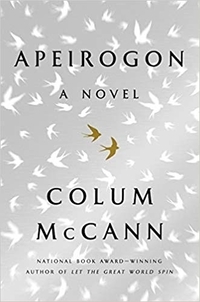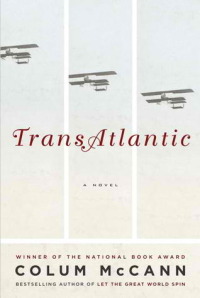Apeirogon by Colum McCann
 Monday, March 2, 2020 at 6:42AM
Monday, March 2, 2020 at 6:42AM 
Published by Random House on February 25, 2020
Colum McCann tells us that an apeirogon is a “shape with a countably infinite number of sides.” In a book that examines the conflict between Israelis and Palestinians, the title is apt. There are more than two “sides” to the conflict; everyone has an opinion. The novel is a balanced attempt to do justice to all the opinions by cutting through the politics and focusing on the deaths of two children, one Israeli and one Palestinian. Apeiron explores how the aftermath of those two real-world deaths illuminates the larger issues that Israel and Palestine face.
McCann tells the reader that Apeirogon is “a hybrid novel with invention at its core” that weaves together “speculation, memory, fact, and imagination.” The novel is remarkable because it is based on two remarkable people. Rami Elhanan, an Israeli, lost his daughter to suicide bombers when she was thirteen. Bassam Aramin, a Palestinian, lost his son to a Border Patrol guard when he was ten. Both men traveled on a complex internal journey before arriving at the realization that their grief was not their own, but was the same grief shared by all parents of children who die violent deaths. The realization that your enemy has feelings, the same feelings that engulf you, sparks the understanding that this person isn’t your enemy at all. A parent who lost a child is not an enemy.
The two men arrived at the same conclusion — ending the Occupation is the only way to achieve peace and justice, to prevent the senseless deaths of more children. They started Combatants for Peace to spread that message. Their position is unthinkable to people who believe they have something to gain from the Occupation. They hope to change minds, one at a time, knowing that some of their audience will refuse to listen. Both men are routinely threatened with violence because they spread a message that entrenched minds cannot bear to hear.
To oppress others is to invite violence. The truth of that statement is evident in the history of countries across the globe. Apeirogon illustrates that truth with two violent deaths. Smadar was blown to unrecoverable pieces by a Palestinian suicide bomber. The rubber bullet that crushed Abir’s skull was fired at the back of her head through a slot in an armored car from a distance of fifteen meters, an act the Israeli military first lied about (claiming she was hit by a rock) and later justified by claiming Palestinians were placing soldiers in mortal danger by throwing stones at their impenetrable vehicle. Abir likely died because the Palestinian hospital in Anata is underequipped and the fifteen-minute ambulance ride to Jerusalem was delayed by two hours at a checkpoint.
In the absence of the Occupation, neither death would likely have occurred. Arguments about the justification for violence on either side can rage until the end of time, but Rami and Bassam (and many others) have come to understand that violence will not end until the Occupation ends. Only then can a political solution be negotiated. Only when Palestinians and Israelis are equally regarded as worthy of life and liberty can peace be achieved.
The story documents the hatred with which both Rami and Bassam are routinely greeted. Some people are more comfortable feeling hatred than living without it. McCann repeatedly quotes François Mitterand’s adage, “The only interesting thing is to live,” in contexts that suggest a refinement: the only interesting thing — to live purposefully — is also a dangerous thing. Both Bassam and Rami place themselves at risk by calling for an end to the Occupation. The irony — people consumed by hate respond violently to calls for peace — is just one “interesting” aspect of living.
But Apeirogon is a novel, not a work of nonfiction. McCann imagines connections between the men that might only be apparent in a novel. A common theme in Colum McCann’s fiction is that we all share a world that connects us in many ways. In Apeirogon, an author’s note attributes to Rilke the notion that we live our lives “in widening circles that reach out across the expanse.” Apeirogon suggests some of the more violent connections. The concoction that the Israeli military sprays onto crowds from water cannons is manufactured in Tulsa, Oklahoma. The M-16 used to kill Abir was manufactured in Samaria, North Carolina. Samaria was the ancient kingdom of Israel; now there are cities and towns named Samaria in many nations. Flying over those towns are migrating birds that know no boundaries.
McCann’s novels often reach out in multiple directions for facts that, until they are assembled, might seem unrelated to the story. Apeirogon addresses, among other topics: falconry, amicable numbers, Sinéad O’Connor, tear gas delivery systems, Borges, the Kaballah, Sir Richard Francis Burton, methods of torture used in the Crusades, Einstein and Freud, swimming pools, Gandhi, German cinema during World War II, the ascetic practices of Saint Simeon, religious scrolls, Philippe Petit, the etymology of “riot” and “dextrose,” Munib Rashid al-Masri’s mansion, pomegranates, the music of John Cage, olive groves, birdsong, and Mossad’s revenge killings of poets and playwrights. The novel also pays tribute to One Thousand and One Nights, both by reference to the famous stories and by breaking the novel into 1,001 chapters (some as short as a sentence).
In the end, a novel like Apeirogon might not change the minds of people who are wedded to a position, but it manages to do something that novelists are positioned to do more skillfully than political writers: it instills feeling. It is impossible for an open-minded reader not to be moved by both Bassam and Rami. Bassam’s life changed in prison and changed again when his daughter was killed. Rami visited the site of his daughter’s death and asked himself what could be done to save other children. McCann makes palpable the suffering of both parents. The story is both moving and inspirational. If only the right people would read it and take it to heart, Apeirogon is a book that could change the world.
HIGHLY RECOMMENDED
 TChris |
TChris |  Post a Comment |
Post a Comment |  Colum McCann,
Colum McCann,  HR in
HR in  General Fiction
General Fiction 